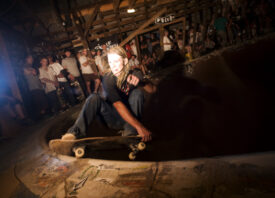Search this site
Powerful Photo Series Examines Post-Tobacco Era Durham, NC
Fireworks burst over the Durham Bulls Athletic Park in revitalized downtown Durham, N.C., July 4, 2014.
Kalin Swinney paused by his first cousin’s casket, 9-year-old Jaeden Sharpe, after his committal ceremony at Beechwood Cemetery. Jaeden was shot in the head as he sat in with his mother in their car near their home on January 4, 2014, and he died January 9. His murder was the first of 2014.
When cities decide to revitalize their less upscale districts, a blind, or at least indifferent, eye is generally turned towards those who stand to lose. Durham-based photographer Justin Cook has been working on Made in Durham, the story of those not included in the wake of this renewal, since he was a student at the University of North Carolina at Chapel Hill, and plans to continue long into the future. The work focuses on what remains in post-tobacco era Durham, amidst education in peril, homicide, and “urban renewal” (for some). He is currently fund-raising for an exhibition of the work, part of which would be a zine involving participation from community members. Cook spoke with us in depth about his work.
How did you come to work on this project?
“The roots of this work began when I was in undergrad at UNC Chapel Hill. I photographed drug raids and shooting scenes with the Durham Police, and later made portraits of mothers where their children had been shot to death. I was forever changed. Since then I’ve sought to understand how violence affects African-American communities in Durham.”
“I continue this work because I feel we all have a civic duty to push America further toward an America as envisioned, not the America fetishized by patriotism, 24-hour cable punditry, and high school history class. I try to do my part with my camera. I want to see America have a better conversation about violence, specifically as a symptom of poverty and segregation. We need to see the cracks in our foundation. The effects of homicide, mass incarceration and gentrification echo an old African-American slave narrative of family severance and longing for place. Every shooting removes men from the community, delivering them to a grave or prison cell. Their mothers grieve themselves to death, their children grow up without parents. One bullet tears through a generation. Mass Incarceration turns men into felons who, like Cain in the Bible, forever wander ground that bears no fruit from their labor.”
“All together it grinds the nuclear family like slavery did. This is the story in Chicago, Detroit and Durham; it is of scale but the same. We can’t continue on this course. The future of America depends on the survival of her young black men, but we put little value on their lives. We need them to outlive their mothers, be our CEOs, invent a cure for cancer; we need them to lead the free world on a better path. Without them, America is unrealized.”

Dennis Lamb, 23, was shot to death on Wabash Street near McDougald Terrace, August 7, 2012. Nearly a year after his death, the teddy bears marking where he died are falling apart.

A baptism on a typical Sunday in east Durham.
Coming at this as an outsider to the community, how easy was it to make contacts and gain access and trust?
“It’s never easy to gain access, but I realized that everyone wants to be heard and if I approach people with open ears, open mind and respect, I just might succeed and even be moved. In Durham I recognize that violence transferred a common trauma between police, paupers, mothers of murder children, ministers, and gang members. I don’t like the word “project”—it’s imperialistic, it implies an imbalance and taking. I like to collaborate instead, which requires vulnerability and giving of myself. I recognize photography is limited, so I go beyond it. A better way is to walk with the grieving and amplify their voices instead of speaking for them.”

Young Crips gather in a circle and remember a fallen brother by spilling liquor.

After a violent summer, locals, led by Pastor Sanders Tate, pray for peace at an east Durham intersection at the beginning of the 2013 school year.
Does Durham feel like a divided city, or is there much crossover in certain communities?
“Durham is curiously egalitarian and segregated. Historically, it’s always been a more progressive place than other southern cities. Under Jim Crow, Durham had a thriving black business class that colluded with the wealthy white tobaccos tycoons who, together, built separate but parallel Durhams. A lot of that scrappy, do-it-yourself spirit lingers, but in new forms. There is no racial majority in the Bull City. Durham pioneered sit-ins during the Civil Rights movement. We have a long-standing black mayor, we’ve had a black police chief. It’s home to North Carolina Central University, a historically black college, and Duke, one of the top universities in the country. Both foster a diverse intelligentsia.”
“But division becomes clear in statistics. UNC Chapel Hill studies and Durham County reports show that blocks from the revitalized tobacco warehouses and restaurants, poverty rates hit 85 percent and high school graduation rates dip to 60 percent. Homicide affects a disproportionate number of African-American and Latino men. It’s the leading cause of death for black men ages 20-39, and the majority happen between acquaintances. This sort of violence is symptomatic of poverty, inflicted by young men who hate their condition. So Durham is emblematic of America’s long struggle with racial and economic injustice. But Durham doesn’t hide its bullshit. All across town, there is an openness and immense pride for the Bull City. There is a generation of young people here who think about race and the American dream in new ways. They are energized, informed and unafraid. They can transform Durham into an example for the rest of America.”

Rashard Johnson kisses his girlfriend Cheyenne after being apart for several weeks in 2012. They eventually broke up because of the instability caused by Rashard’s criminal record. Rashard grew up without a dad and his mother struggled to make ends meet. By 18 he had been convicted of several nonviolent property crime felonies. At 20 he has escaped gang life and wants to start over, but is fettered by his past and debts owed from his crimes. As a felon, he faces employment, education and housing discrimination, cannot vote, and struggles for stability.

Rashard at the Durham County Detention Center, after being arrested for cutting off his house arrest ankle monitor, violating his probation, and going on the run for over two months. Without a GED or a job, Rashard couldn’t repay his debt and succumbed to frustration. 2012.
How much does the revitalization of Durham seem to really affect or intrude upon the lives of inner-city residents?
“Of course many Durham neighborhoods have long been in flux, and revitalization is a double-edged sword. In the 1970’s the Durham Freeway was built through Hayti, bisecting Durham’s vibrant African-American community. White flight to the suburbs accelerated when industry and inner cities declined nationwide. When Durham’s tobacco industry went bust, downtown wasn’t a place to be after 5 o’clock.”
“Now that downtowns are cool again, the reverse is happening: young professionals and families are flocking to the city, renovating the infrastructure and making downtown profitable again. Naturally, they all want to live near where they work and play, so the downtown neighborhoods are being “gentrified.” Old houses in neighborhoods decimated by de-industrialization are flipped for twice their value, expensive condos sprout from the rubble where condemned homes once stood and rent around downtown climbs. There is an acute affordable housing shortage in Durham, and many longtime residents can’t afford Durham’s new vision, so they search for home again. This is when “revitalization” feels like an uprooting. So how do you revitalize Durham while preserving the people who have always been there?”
Have you been able to continue following certain families or individuals?
“Yes, but in evolving ways. Some of my collaborators have fallen off the radar. With others my relationship has morphed into companionship. At the end of the day, I doubt my photos will make a dent in the universe. But relationships change hearts. They changed mine. I need the relationships formed from this project. I would be nothing without them.”

“I just want to go dig up his body so I can touch his face one more time,” says Joslin at her son’s grave in Beechwood Cemetery in 2007.

Community is formed from grief as mothers laugh and weep when they remember their murdered sons and daughters during a Circle of Hope and Healing, held for grieving parents by the Religious Coalition for a Nonviolent Durham at Shepherd’s House United Methodist Church in East Durham.

Bonnie Turner, mother of Jeremy “J-Berg” Lamar Turner who was shot to death May 17, 2011, when he was 19 years old. She remembered him in July 22, 2013 on what would have been his 22nd birthday.

Demolition and construction continue in Durham’s Southside neighborhood. Non-profits have partnered with the city of Durham to reclaim land in the neighborhood for an urban renewal project. The goal is to build nicer and affordable low-income housing and revitalize the area. But some Southside residents are weary of gentrification and urban infill in their proud, historically black neighborhood. They look to past urban renewal projects in Durham, including the construction of the Durham Freeway, that they feel dislocated a once centralized and vibrant black community. Many residents dub these projects “Urban Removal.”

Achievement Academy of Durham’s GED graduation in the commissioner’s chambers at the Durham County Courthouse. Programs like the Achievement Academy improve the lives of high school dropouts and at-risk students who often have learning disabilities and difficulty learning in traditional classrooms. The GED is the start of a path to empowerment.

Young men revel along Fayetteville Street during Hillside High School’s homecoming parade. Hillside has a predominantly African American student population and serves many low income communities in south and east Durham. Hillside once had graduation rates as low as 50 percent but has improved it to 83 percent.

Allen Jones, a minister and mortician, helps officiate a vigil for Jermaine Andre McDonald, 37, who was shot to death June 18, 2013 in Durham. Allen and and his son Tyrone knew “Dre,” as he was known to friends, very well and they were enraged and saddened by his death. Dre had helped Allen with his mortuary work in the past. and Tyrone bought his pit-bull from him. Increasingly frustrated by the violence in his community, Allen became a minister in early 2013 and began collaborating with local social justice organizations to work towards solutions.

Durham Police officer J. Love discovers a concealed handgun during the search of a car in Durham in 2005. There were 37 homicides in Durham in 2005. Twenty seven (73%) were committed with a firearm. Similar statistics persist in the years since.
All images © Justin Cook.





